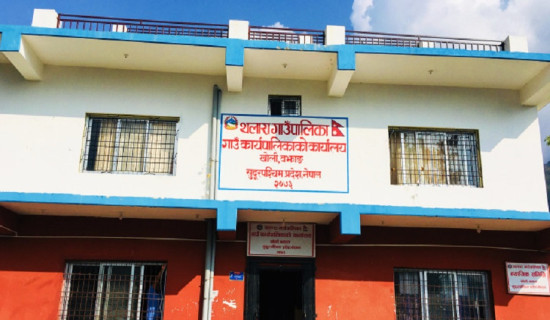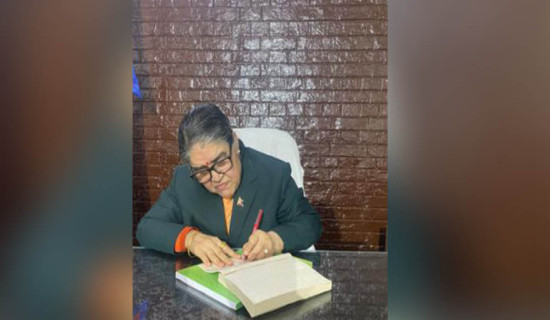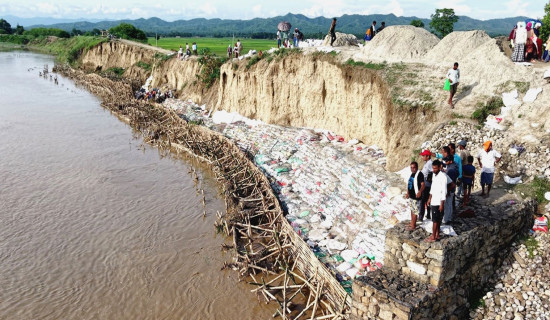- Wednesday, 16 July 2025
Blue-green spaces can reduce Kathmandu's urban temperature: Study
By A Staff Reporter,Kathmandu, June 17: A study published recently in the journal, Urban Climate, has found that strategically designed green spaces and water bodies in the Kathmandu Valley can reduce urban temperatures by up to 1.6 degrees Celsius.
The research conducted by researchers, including Saurav Bhattarai, a PhD student at Jackson State University, USA and an ORISE fellow, found that having parks, forests and ponds can measurably cool city temperature by 0.8 degrees Celsius to 1.6 degrees Celsius.
The research was done by an international team from seven institutions, including Jackson State University (USA) and Tribhuvan University. The Study analysed 301 parks, 130 forest patches and 26 ponds across the Kathmandu Valley's high-density urban areas using satellite-based information and Machine Learning algorithms.
According to research, some locations show cooling differences of up to 4.1 degrees Celsius between green spaces and urban areas.
The research also said that Kathmandu's temperatures have been rising by 0.38 degrees Celsius per decade since 1976, and central urban areas are already 2 degrees Celsius to 3 degrees Celsius hotter than surrounding regions. Due to increasing heat in the Valley, soil moisture has dropped by 35 per cent in some urban areas, it said.
Bhattarai said that the research closely examined how different types of blue-green spaces help cool down cities areas across the Kathmandu Valley.
Temperature differences are dramatic
Temperatures go up as you move away from blue-green spaces like forests, parks and ponds. The study showed that Swoyambhu forest stayed cooler at 31.9 degrees Celsius, while nearby city areas reached 36.0 degrees Celsius, a difference of 4.1 degrees Celsius.
At UN Park, the temperature was 34.3 degrees Celsius, compared to 38.2 degrees Celsius in the surrounding buildings, a difference of 3.9 degrees Celsius. A traditional pond, Na Pukhu, in Bhaktapur measured 39.6 degrees Celsius, while the nearby urban area hit 42.5 degrees Celsius.
The number represents the highest cooling effects recorded over five summers, highlighting how much these blue-green spaces can help during the hottest times, Bhattarai said.
Similarly, the temperature at Ranipokhari’s centre was 37.1 degrees Celsius, while nearby streets reached 39.8 degrees Celsius, a cooling difference of 2.7 degrees Celsius. The cooling effect spreads about 150 metres from the water's edge, with the strongest cooling felt within the first 100 metres.
In Bhaktapur, Siddha Pokhari Pond showed 36.0 degrees Celsius compared to 38.5 degrees Celsius in nearby built-up areas. Meanwhile, in Lalitpur, Pimbahal pond kept the area cooler, showing 38.3 degrees Celsius vs 40.4 degrees Celsius in the surrounding areas. The cooling effect can be even felt up to 300 metres away from the water.
Overall, urban forests provide the greatest cooling effect, lowering temperatures by up to 1.2 degrees Celsius on average. Parks come next, cooling up to 0.9 degrees Celsius and ponds can reduce temperatures by up to 0.85 degrees Celsius.
“But how well these spaces cool depends a lot on their surroundings. In vegetation-dominated areas, blue-green spaces can cool temperatures by as much as 1.6 degrees Celsius, while in densely built areas, the cooling effect drops to just 0.3 degrees Celsius to 0.6 degrees Celsius,” Bhattarai said.
Bhattarai said our findings show that effective cooling strategies should be tailored to specific urban contexts. “Just adding green spaces is not enough; they need to be carefully designed and well-integrated with the surrounding city environment,” he said.
Dr. Rocky Talchabhadel from Jackson State University stressed the need for urgent action. “Our study shows that Kathmandu's high-density areas are at greater risk from extreme heat. Without immediate action, these urban heat islands will only get worse,” he said.
Prof. Vishnu Prasad Pandey from Tribhuvan University said that strategic placement and design of blue-green spaces can maximise cooling benefits even in space-constrained urban areas. “This is not just about planting more trees. The internal composition of parks - the ratio of tree canopy, grass and impervious surfaces - determines their cooling effectiveness more than their size alone,” he said.
Dr. Prajal Pradhan from the University of Groningen, Netherlands, stressed the global applicability of the findings and methods. “Cities globally can learn from our findings based on the Kathmandu Valley. We provide a framework for assessing cooling potential that can be applied anywhere and used to plan cities to adapt to urban heat,” he said.
Dr. Nawa Raj Pradhan from the US Army Engineer Research and Development Centre warned that if no action is taken, increasing temperatures will put pressure on public health systems, increase energy demands for cooling and disproportionately hit vulnerable communities the hardest. The study estimates that implementing comprehensive cooling strategies could reduce urban cooling energy demands by 15 per cent to 25 per cent, potentially saving significant electricity costs while improving public health outcomes.

















